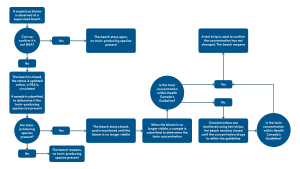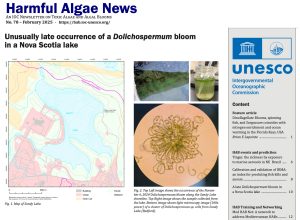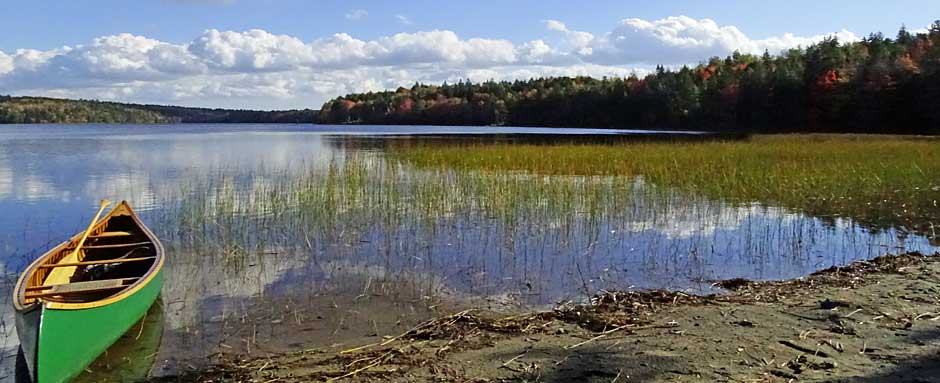
Screenshot from Lisa Abott’s post on Talk Bedford, with permission from L.A.
Click on images on this page for larger versions
Sandy Lake was listed on the NS Gov.’s Blue-green algae webpage as a site of a potential BGA (Blue-green algae) bloom earlier this month. That post followed a report with photos sent to the provincial government, and posted by Lisa Abbot on the public Facebook Page “Talk Bedford” on Sep 2, 2025.
Lisa comments that the photos were taken “at Sandy Lake – area where dogs like to swim”, presumably at or close to Sandy Lake Beach Park. A respondent to the post commented “I noticed it yesterday as well down the other end of the lake”, providing a photo as well.
It was the latest potential bloom for NS lakes so far this year when first reported on the NSGov website (circa Sep 11, 2025) on the NS Gov’s Blue-green algae webpage , subsequently another September bloom has been reported, that for Flat Lake (near Stillwater Lake) in Upper Tantallon.
The NS Government does not routinely examine all such reports to confirm or not that it a particular report is in fact a BGA bloom and whether or not it is toxic; my understanding is that they follow up for certain only when the bloom occurs in a source of drinking water.

BGA decision tree used by HRM. Diagram posted on HRM webpage Beaches, outdoor pools, and splash pads
If the reported bloom occurs on an HRM-supervised Beach between July 1 and Aug 31, there is routine followup by HRM: “If a suspected blue-green bloom is observed at one of our supervised beaches, the beach is closed immediately, and water samples are analyzed for toxins. The supervised beach is re-opened once water sample results are within Health Canada guidelines.” Sandy Lake Beach is a supervised beach but this observation occurred outside if the supervisory period, so likely was not followed up, at least not by HRM.
The province lists previous reports of potential BGA blooms: see Reported blue-green algae in previous years (PDF)
Besides the bloom listed for Sandy Lake Bedford for September 2025, blooms are cited for September 2024 and June 2022. The June 2022 bloom was followed up and was not associated with BGA. – see Note 40.

The Nov 6, 2024 BGA bloom on Sandy Lake was featured in an article in Harmful Algae News, a UNESCO publication. Click on image for details.
There has been no reported followup for the Sep 2024 bloom.
However, a BGA bloom has been confirmed for Sandy Lake within the last year. A resident observed an algal bloom on Nov 6 2024 which I followed up with the collaboration of Saint Mary’s University limnologist Prof. Linda Campbell, and BGA specialist Michael Agbeti; it was confirmed as a bloom of a toxin-producing BGA. Further, our various volunteer observations of limnological characteristics of Sandy Lake provided pretty convincing evidence that the bloom coincided with lake “turn over” in the fall of 2024, bringing up phosphorus-rich deep water produced when deeper waters went anoxic during summer stratification.
The Nov 2024 BGA event unfortunately adds to the evidence that “Internal Phosphorus Loading” is occurring in Sandy Lake, a sign that the lake is in trouble now, and likely to be seriously impacted by the proposed and now-in-the-secondary-planning stage development to accommodate up to 18000 residents on SW side of Sandy Lake.
Independent of that issue, such a late BGA bloom is unusual, and the SMU group, with the help of the Sandy Lake Volunteers is following up with more studies on Sandy Lake to help better define what drives BGA blooms in Nova Scotia and how they are influenced by climate change. If further blooms by visitors to Sandy Lake are observed, the SMU group would appreciate receiving a sample of water from the bloom area to determine if the bloom is associated with BGA. The sample can be collected by simply scooping some water up in a clean bottle, capping it and storing it in a refrigerator; contact Jessica Yonker and Prof Linda Campbell at SMU* to report the observation and to arrange taking the sample to SMU or having it picked up.
And then you can officially consider yourself a “Sandy Lake Volunteer” and a “Citizen Scientist!
*younker@smu.ca, LM.Campbell@smu.ca
